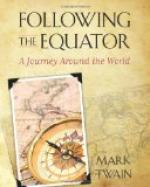The early whites were not used to savages. They could not understand the primary law of savage life: that if a man do you a wrong, his whole tribe is responsible—each individual of it—and you may take your change out of any individual of it, without bothering to seek out the guilty one. When a white killed an aboriginal, the tribe applied the ancient law, and killed the first white they came across. To the whites this was a monstrous thing. Extermination seemed to be the proper medicine for such creatures as this. They did not kill all the blacks, but they promptly killed enough of them to make their own persons safe. From the dawn of civilization down to this day the white man has always used that very precaution. Mrs. Campbell Praed lived in Queensland, as a child, in the early days, and in her “Sketches of Australian life,” we get informing pictures of the early struggles of the white and the black to reform each other.
Speaking of pioneer days in the mighty wilderness of Queensland, Mrs. Praed says:
“At first the natives retreated before the whites; and, except that they every now and then speared a beast in one of the herds, gave little cause for uneasiness. But, as the number of squatters increased, each one taking up miles of country and bringing two or three men in his train, so that shepherds’ huts and stockmen’s camps lay far apart, and defenseless in the midst of hostile tribes, the Blacks’ depredations became more frequent and murder was no unusual event.
“The loneliness of the Australian bush can hardly be painted in words. Here extends mile after mile of primeval forest where perhaps foot of white man has never trod—interminable vistas where the eucalyptus trees rear their lofty trunks and spread forth their lanky limbs, from which the red gum oozes and hangs in fantastic pendants like crimson stalactites; ravines along the sides of which the long-bladed grass grows rankly; level untimbered plains alternating with undulating tracts of pasture, here and there broken by a stony ridge, steep gully, or dried-up creek. All wild, vast and desolate; all the same monotonous gray coloring, except where the wattle, when in blossom, shows patches of feathery gold, or a belt of scrub lies green, glossy, and impenetrable as Indian jungle.
“The solitude seems intensified by the strange sounds of reptiles, birds, and insects, and by the absence of larger creatures; of which in the day-time, the only audible signs are the stampede of a herd of kangaroo, or the rustle of a wallabi, or a dingo stirring the grass as it creeps to its lair. But there are the whirring of locusts, the demoniac chuckle of the laughing jack-ass, the screeching of cockatoos and parrots, the hissing of the frilled lizard, and the buzzing of innumerable insects hidden under the dense undergrowth. And then at night, the melancholy wailing of the curlews, the dismal howling of




